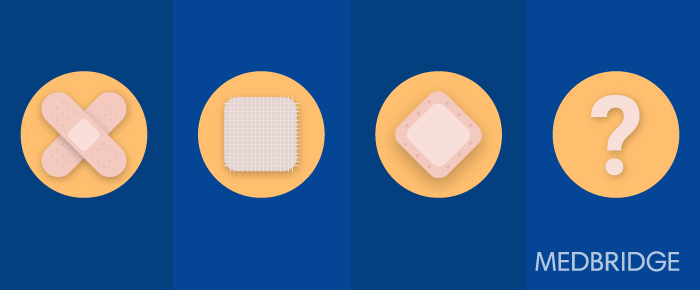Wound Dressings: A Systematic Approach to Absorptive and Occlusive Dressings

An area in wound care that has dramatically changed is the ability to choose from a wide variety of wound dressings. Traditionally, gauze dressings would predominate as the choice for protecting an open wound. Today there are many dressing options that can be used based on wound presentation.
Some factors impacting wound dressing choice:
- Wound depth
- Presence of infection
- Percentage of healthy granulation tissue
- Amount of exudate
All wounds should not be treated the same. The selected dressing should provide the optimal environment for the unique needs of the wound being treated.
Absorptive Dressings
Dressings can be classified based on their degree of absorbency and occlusion. Absorptive dressings are indicated if a wound has a high level of drainage. If the chosen dressing is not absorptive enough, the wound and surrounding tissue will become macerated. This will impede the normal healing process and put the surrounding tissue at risk for skin breakdown.
Seeing if drainage is seeping through or around the dressing and inspecting for wound and periwound maceration between dressing changes is a good way to check if a dressing is absorptive enough.
Good absorptive dressings include:
- Foams
- Hydrofibers
- Calcium alginates
Venous stasis wounds typically have a significant amount of drainage and would benefit from an absorptive dressing along with some form of compression to improve venous return and control for edema.
Occlusive Dressings
For a wound that is very dry the use of a “moisture donating” dressing is recommended. A dry environment is not ideal for a wound to move though the inflammatory and proliferative phases of healing. Occlusive dressings that are less permeable or porous will help to seal in the same natural moisture that intact skin provides for underlying tissue. Occlusive dressings, such as transparent films or hydrocolloids, will help to prevent a wound from drying out and can assist with autolytic debridement.
Hydrogel dressings are a good choice to add moisture into deep dry wounds and are obtained from a tube or incorporated directly into a dressing. An individual with a Stage III or IV pressure ulcer that lacks moisture could be treated with hydrogel to fill in the wound cavity followed by a secondary occlusive dressing to seal in the needed moisture. Once the proper dressing is in place, pressure redistributing devices and good patient management will help heal the pressure ulcer.
One type of dressing does not meet the needs of all wounds, so it is important to always evaluate the wound and its needs for successful healing. Awareness of the wound presentation should help the clinician choose the most appropriate dressing.









